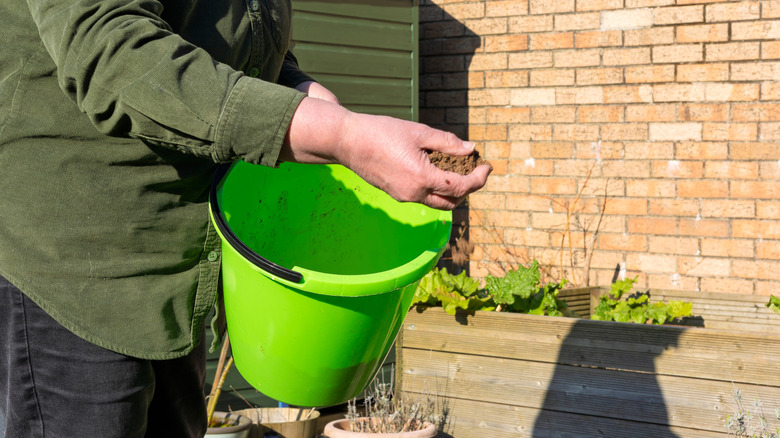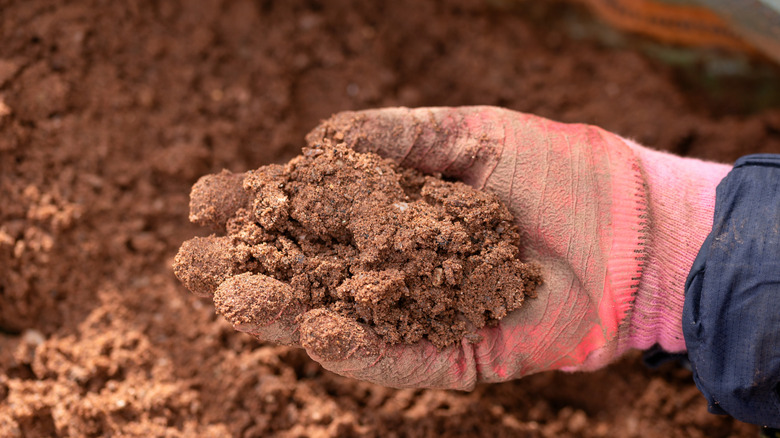What Is Sharp Sand And Is It Right For Your Garden?
Who knew the words sharp, sand, and garden could be in the same sentence? Contrary to what you're probably thinking, sharp sand can work wonders for your garden in the right conditions. Unlike the fine, soft sand you'd enjoy at the beach, sharp sand has large, angular grains. Also known as grit sand, sharp sand has a coarse texture that makes it beneficial in gardening by improving soil drainage and aeration.
This kind of sand is a lifesaver for waterlogged gardens. If your soil holds moisture like a sponge, mixing in sharp sand can help excess water drain away, reducing the risk of root rot. Sharp sand's coarse grains create tiny air pockets in dense soil, giving roots room to breathe. Unlike fine sand that easily gets compacted, its rough texture prevents soil from packing down too tightly. This improved airflow helps plant roots grow stronger and access nutrients more easily.
Sharp sand is sometimes used to loosen heavy soil like clay, breaking up dense clumps and making it easier for plants to establish strong roots. This can be achieved by mixing sharp sand and soil or compost with clay soil in a 1:1 ratio to loosen the pores. However, it's best only to do this with raised beds and to incorporate organic matter with the sand. This is because trying to improve heavy clay soil in your entire garden will require an immense amount of sand, which is really not feasible.
Practical ways to use sharp sand in gardening
One of many clever ways to use sand in your garden, including sharp sand, is to create free-draining potting mixes for plants like alpines that don't thrive in water-saturated soil. This is done by mixing sand with an equal amount of compost in a planter with enough drainage holes. Potting mix with this combination of sand and compost is an ideal soil environment for herbs and succulents to thrive in. These kinds of potting mixes also help to prevent damping off, a fungal disease that rots the base of newly sprouted plants, and may be the reason your seedlings are falling over. Sharp sand improves drainage in mixes, preventing the soggy conditions where damping-off fungi thrive. This makes a great environment for sowing seeds and propagating cuttings.
However, you have to be careful not to feed your soil sharp sand containing lime residues, which could raise the soil's pH level. This becomes a problem for sensitive seedlings and plants that love acidic soils such as blueberries, witch hazel, and azaleas. Sometimes, these sands may be construction-grade and are often not washed or sterilized, containing impurities, making them unsuitable for soil health. Additionally, don't make the mistake of adding sharp sand in excess or using it to plant without compost. This will create a sandy soil mixture that drains too quickly, meaning it won't retain moisture or nutrients, therefore it will be unsuitable for gardening.
Other types of sand that help with soil drainage and aeration
You've probably heard about horticultural sand, which many people tend to call sharp sand and vice versa. That's because both have a gritty texture, help to boost water and air in the ground, and can be used to loosen up heavy soil. In terms of composition and texture, horticultural sand consists of both large and small particles, usually from crushed quartz, sandstone, or granite. But as we said, sharp sand consists solely of large angular grains. Horticultural sand also scores higher in purity as it's cleaned to remove harmful lime and salts that could affect the soil pH. These extra refinements make this sand more expensive than the rest since it's created specifically for gardening.
Builder's sand is the kind of sand often used in construction sites. In gardening, the coarse type of this sand can be an affordable substitute for sharp sand, helping with water and air distribution in the soil. However, fine builder's sand could be detrimental to your garden. This is because its rounded grains and fine texture can pack tightly when wet, creating a cement-like soil texture that can suffocate plant roots and intensify the drainage problems you're probably already dealing with.
Vermiculite and perlite are not types of sand, but they are common minerals used in gardening that can also help with compacted and waterlogged soil, respectively. Vermiculite is typically used for soil aeration and water retention. However, perlite can help with both draining and holding water in soil, as well as aerating it.


